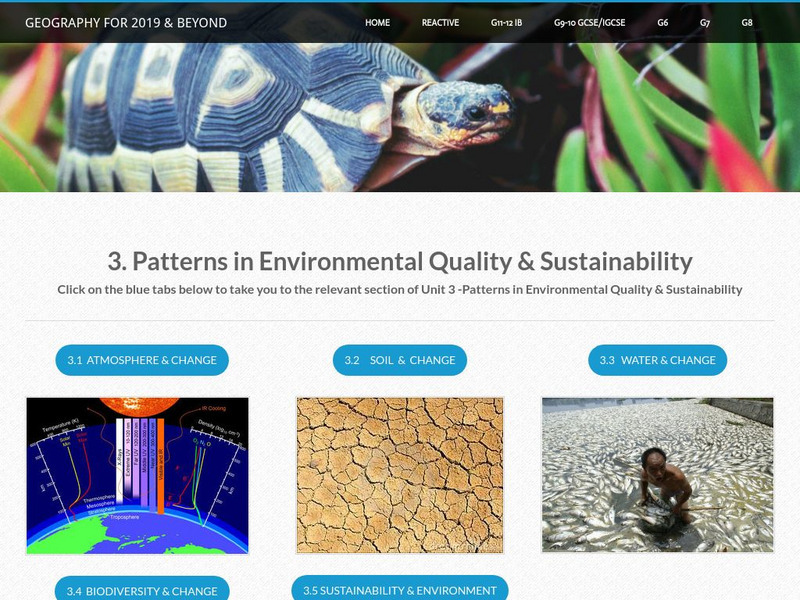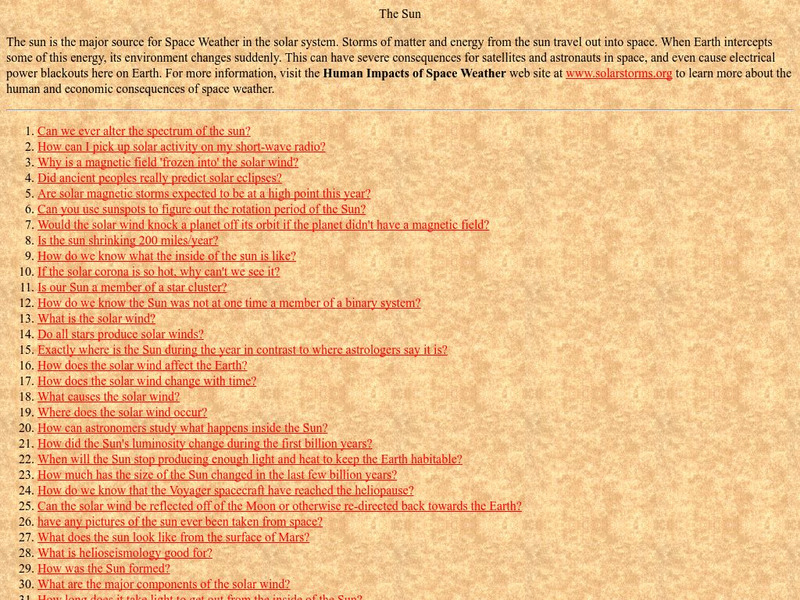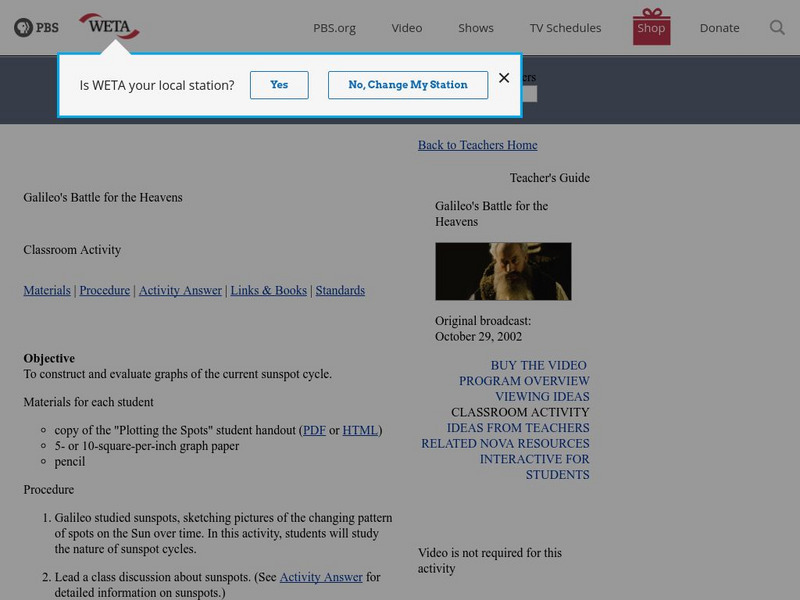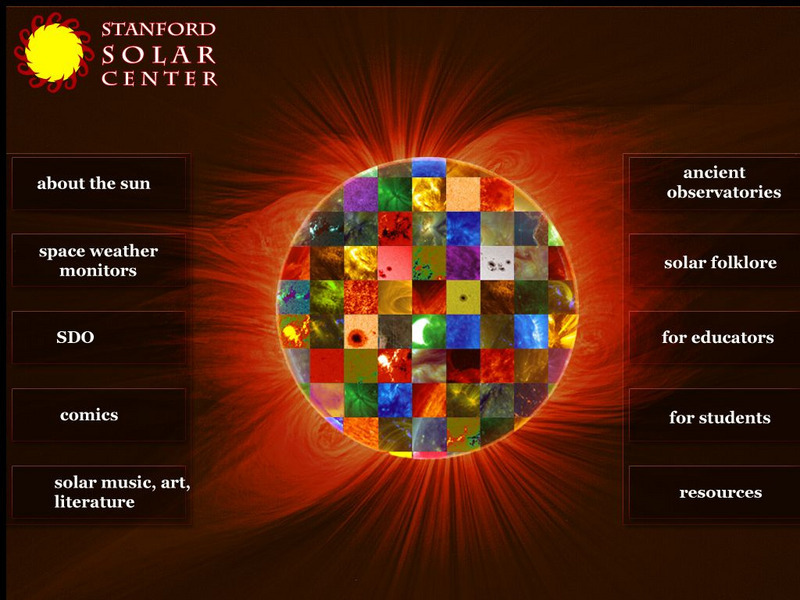PBS
Pbs Learning Media: Characteristics of the Sun
This video segment adapted from NASA describes the basic characteristics of our star, the Sun. Includes background reading material and discussion questions. Video length: 1 min. 28 sec.
Geographypods
Geographypods: Patterns in Environmental Quality and Sustainability
This collection of five learning modules looks at issues related to environmental change and sustainability. Topics addressed include changes in the atmosphere, soil, water, and biodiversity, and what can be done to counteract this and...
PBS
Pbs Learning Media: Sunspots on the Move
The following videos show sunspots using wavelengths of light that the human eye cannot see. Watch sunspots emerging on the earth's surface, a sunspot moving across the earth's surface, and the rotation of the sun as a sunspot evolves...
NOAA
Noaa: Space Weather Prediction Center: A Primer on Space Weather
The Space Environment Center put together an introduction to our sun and space weather that it creates during it's 11 year weather cycle. Learn about different solar anomalies and the effects they have on earth with pipelines, geologic...
NOAA
Noaa: National Weather Service: The Sun and Its Effect on the Earth [Pdf]
The Space Environment Center (SEC) put together a slide show for use by teachers on Space weather. Begin with discussing solar emission and the sun itself. Then end with a summary of climatic effects of space weather, and a note on space...
NASA
Nasa: Image Science Center: Ask the Space Scientist
A NASA space scientist provides 98 questions and answers about the sun, the center of our solar system.
Nine Planets
The Eight Planets: The Sun Solar Wind
This Eight Planets site briefly describes solar wind, a low density stream of charged particles emitted by the Sun. It also provides the basics on the sun's composition and additional sun links.
PBS
Pbs Learning Media: Jewel Box Sun
See the sun like you have never seen it before! Using a specialized telescope, NASA developed images of the sun created from a wide range of wavelengths of light. Each wavelength is represented by a different color making a beautiful...
PBS
Pbs Learning Media: Images of the Sun
We think of the sun as being bright yellow, however, the sun is actually different colors based on whether the sun is in an active stage. Scientists used telescopes and satellite cameras to take these stunning photographs of the sun....
University Corporation for Atmospheric Research
Ucar: The Sun Earth Connection: Sunspots and Climate
Through graphing data and interpretation, students learn about sunspots and their effect on the climate of our planet.
University Corporation for Atmospheric Research
Ucar: Sun and Space Weather Image Gallery
Images and diagrams of the Sun, solar phenomena such as sunspots and flares, space weather, Earth's magnetosphere and upper atmosphere, the aurora, and more.
Exploratorium
Exploratorium: Solar Max 2000
Examines the solar maximum cycle that occurred in the year 2000. Describes the characteristics of sunspots, solar flares, and coronal mass ejections, using video, photographs, news reports, and similar resources.
PBS
Pbs Teachers: Galileo's Battle for the Heavens Plotting Sun Spots
In this activity, students follow in Galileo's footsteps as they examine the nature of sunspot cycles, define solar minimum and solar maximum, and graph data for a solar cycle. Then they will predict the next solar maximum and when the...
PBS
Pbs Learning Media: Giant Sunspots
The sun isn't a solid yellow ball in the sky. It is a ball of boiling, churning gasses which cause the sun to have turbulent activity at times. Sunspots form in these active areas. View pictures from NASA of these giant sunspots. Also...
Other
Ypop: Using the Computer to Measure Sunspots
This site provides a tutorial on using computer image processing techniques to measure the size of sunspots and analyzing various phenomena visible in solar images. It also provides lesson plans for teachers to use in class.
NOAA
Noaa: Ngdc: Sunspot Numbers
This brief article examines the historical work on sunspot recording by Rudolph Wolf. Also discusses how sunspot numbers are calculated today and provide graphs of sunspots numbers from past years.
NASA
Nasa: Space Place: What's the Sun's Mood Today?
Find out about characteristics of our solar system's main source of energy, the sun.
NASA
Nasa: Imagine the Universe: The Sun
Site discusses the regions of the Sun's atmosphere such as the Photosphere, Chromosphere, and Corona. Provides sources for educators as well as additional links for students.
Nine Planets
The Nine Planets: The Sun Facts
Statistical data, general features, key terms, characteristics, and influences of the sun.
Read Works
Read Works: The Sun Heats Up
[Free Registration/Login Required] An informational text about the sun. A question sheet is available to help students build skills in reading comprehension.
NASA
Nasa Star Child: The Sun
Get to know our nearest star with this introduction to the sun. Listen to the information in an audio file. Vocabulary words are linked to a glossary of terms. Features include links to other interesting facts and a printable version of...
NASA
Nasa Star Child: Star Child
StarChild from NASA defines and describes the Solar System in a simple and easy-to-understand manner. The website is broken down into two versions for the student, grade school and junior high.
Stanford University
Stanford Solar Center: About the Sun
The Stanford Solar Center provides information about the sun, activities, solar art, and solar folklore.
NASA
Nasa: Solar Data Analysis Center: The Solar Wind
This site provides insight into research, both past and present, regarding solar wind. Content includes a focus on what solar wind is and its cause.
















